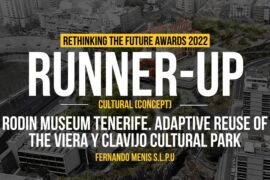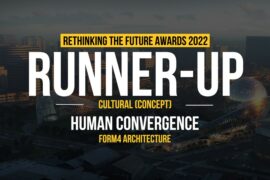On April 27, 1967 Place des Nations hosted over 8,000 people for the opening ceremony of Expo 67 which many refer to today as the most successful world exposition in history. Place des Nations was the physical manifestation of the expo’s overarching themes of global unity and forward-thinking progress while Place des Nations acted as the ceremonial epicentre of the event.
Architects: Tyler Mohr
Completed at the Harvard Graduate School of Design
Under the instruction of Renee Daoust and Aisling O’Carrol

Bringing together architecture, art, media, technology, and most importantly – people, the success of Expo 67 led to the worldwide recognition of Montreal as a hub for design and culture. Despite its historical significance, the popularity of the attractions proved to be short-term as time has not been kind to the former Expo 67 site. Many of the attractions have long since been disassembled and removed leaving only a select few ruminants on the site. With the exception of Buckminster Fuller’s geodesic dome and a derelict amphitheatre (Place des Nation), one might find it difficult to image a bright and vibrant world’s fair taking place on Ile St. Helene. Today, Place des Nations exists as a mere shadow of its former iconicity, recognizable only by the nostalgia invoked to those who experienced Expo 67 firsthand.



This project focused on Place des Nation, the historic amphitheatre on the southernmost tip of Ile St. Helene, as a project site. As the site has aged with limited maintenance and upkeep, Place des Nation has been rendered unusable. With weathered beams and an abundance of structural liabilities, the site has been fenced off and for all intents and purposes, shut down.

The design for Place des Interactifs is rooted in the spirit and energy that once occupied Ile St. Helene during Expo 67 and the same energy currently thrives in the city of Montreal. The largest design challenge when thinking about a site like Place des Nation is reconciling its history and cultural significance while finding a way to bring it to life without neglecting or overshadowing its history.

The city of Montreal is authentic and full of energy. Stimulation is embedded within its culture – whether it’s the annual Festival of Lights, the city’s vibrant nightlife, or the dramatic seasonal temperature changes, residents and visitors of the city find no shortage of excitement and stimuli. Place des Interactifs builds on this diversity of experiences and stimulation by establishing the former Place des Nation site as an interactive gathering place for residents and visitors. Using architecture firm Daoust Lestage’s masterplan for Parc Jean-Drapeau (Ile St. Helene) as a point of departure, Place des Interactifs envisions the former amphitheatre as a flexible public space with the ability to facilitate larger events, such as the Osheaga Music Festival, as well as take centre stage as an interactive light exhibit.

The existing structures and architecture were approached with sensitivity – proposing only to retrofit interiors and restore hazardous elements. The majority of the design can be viewed as “strategic incisions and additions” to the iconic site. The centrepiece of the design equips the central ground of the amphitheatre with interactive lighting and infrastructural elements that can be programmed according to its usage – Natural gas hookups and integrated attachment locations for when the site is needed to function as the back of the house for larger festivals to interactive lighting for when hosting performances or gatherings.

Large movable beam lights at the tops of the amphitheatre plinths project light into the sky, allowing people to see the light movement from across the river. The notion of interactive lighting plays into the city’s fascination with light as well as provides for a non-singular visual experience. When the site is in use, even by one person, the site has the ability to change appearance via lighting and demarcate its usage to the surrounding people.

Platforms project from the voids in the amphitheatre and metaphorically “extend their reach” beyond the islands bounds calling attention to the site while simultaneously offering vantage points of the city and the Saint-Laurent River. Each of the three projections focuses on and emphasize a particular sense.

The first of the projections is the Visual Dock. Oriented towards the city of Montreal on the western side of the island, the dock hovers over the river. A canopy structure influenced by the “Man and His World” logo of Expo 67 offers a deceiving anamorphosis-like reveal of the city skyline in the distance. Dappled light shines through the voids in the canopy and creates a rhythm with the interactive ground lighting elements that extend out from the central gathering space.

The second of the projections is the Aroma Dock. The only one of the projections that don’t break the edge of the island, the Aroma Dock focuses on the sense of smell and serenity, floating above Lac des Cygnes just north of the Place des Nation amphitheatre.

Utilizing inherited geometries from Expo 67 to inform it’s angular planters, visitors that were at the original expo will be invoked with the nostalgia of the Expo’s tulip-lined esplanade while first-time visitors can enjoy the aroma while viewing Buckminster Fuller’s Geodesic Dome just beyond the trees.

The final projection is at the tip of Ile St. Helene. Extending south beyond the split in the river, the two-level dock facilitates views towards the city as well as promotes its users to get close to the water. Entitled The Sound Dock as it is one of the few locations on the island where users are encouraged to engage with the water.

During the winter, the water freezes pushing sheets of ice downstream and those brave enough to visit on a cold Montreal day, will be rewarded with an up-close view (and sound) of rushing sheet flows of ice and water.

The ultimate goal of Place des Interactifs is to create dynamic public space, in terms of both usage and appearance. The site’s inherent history is fundamental to the development of Montreal as a global hub for design and culture, thus, a sensitive approach that doesn’t inhibit its iconic appearance is key. Establishing Place des Interactifs as an urban beacon for the city of Montreal, invoking sensory appeal, and equipping the site with versatile infrastructure suited to promote a variety of programs will establish Place des Interactifs, once again, as the symbolic and beating heart of Montreal while maintaining it’s historic identity.


Tyler Mohr
Tyler Mohr is a Senior Designer at Surfacedesign Inc. in San Francisco and a Digital Media instructor for the [IN]LAND program at UC Berkeley. He received his Bachelor’s Degree in Landscape Architecture at Colorado State University and his Master’s in Landscape Architecture at The Harvard Graduate School of Design. Prior to joining Surfacedesign, Tyler worked as in intern for Michael Van Valkenburgh Associates, Reed Hilderbrand, and contributed contracted design work for Ground Inc. Tyler’s research as both an undergraduate and masters student focused on large-scale design, infrastructure, and design representation. While at Harvard, Tyler worked as a Teaching Assistant and had multiple projects featured in the Graduate School of Design’s annual “Platform” Exhibition and Publication. Tyler has been awarded a Student ASLA Award, recognized as the Outstanding Senior in Landscape Architecture at CSU, and has contributed work to a variety of Landscape Architecture and Design publications. In addition to his experience within the landscape architectural discipline, he has worked as a graphic designer and regularly writes and produces music.
Tyler draws on his own education as well as his experience in landscape architecture, graphic design, and music to inform his methodology. He believes that there is no singular way to approach design, which enables him to facilitate his students’ and his own design progression uniquely. Tyler’s holistic view of design promotes design learning through an explorative lens. He believes that placemaking and design can be understood by utilizing a variety of media types, from physical model making to digital simulation. Tyler aims to push the boundaries of the design by introducing and exploring non-conventional approaches and pedagogy.





